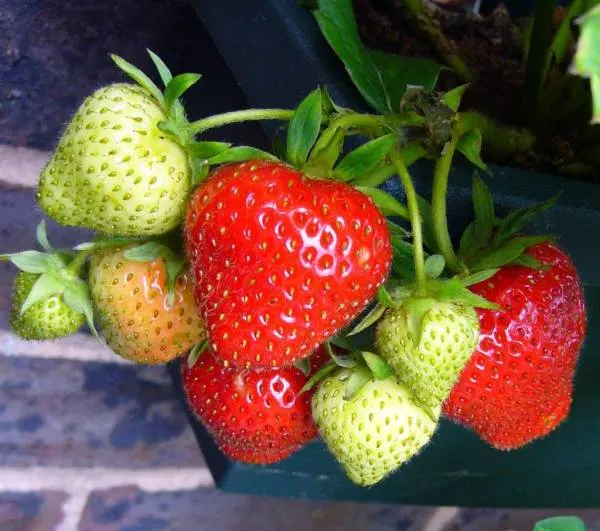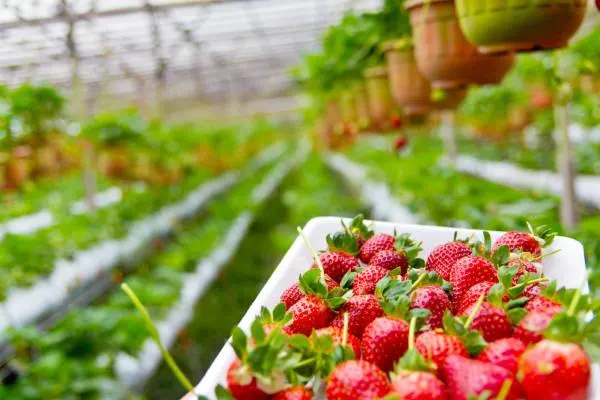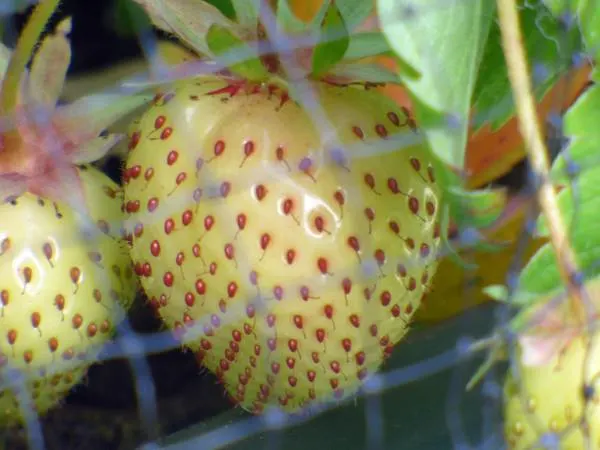Growing Strawberries in gutters is the best way to save space in your garden and produce fresh juicy strawberries.
It’s so cool and seems to be a great way of growing strawberries. You may have seen strawberries grown in gutters, and I think most people are growing them so that the rain and soil cannot rot them. Growing strawberries in gutters actually looks clean and beautiful.

We got many requests about growing strawberries in gutters as many people seem to have no space in their gardens for producing beautiful and tasty strawberries. Hence, they prefer to grow them in planters.
This article is all about growing strawberries in gutters, its benefits, and some of its drawbacks. If you are excited about this topic, let’s get straight into it.
- Growing Strawberries in Gutters
- How to Grow Strawberries in Gutters?
- Spout Gutters — One of the Leading Rain Gutter Professionals
- DIY Gutter for Growing Strawberries
- Some Pro Tips for Growing Strawberries in Gutters
- Benefits of Growing Strawberries in Gutters
- Effects of Growing Strawberries in Gutters
- Is Growing Strawberries in Gutters Safe?
- Inventive Gutter Garden Ideas
- Conclusion
Growing Strawberries in Gutters
The flavor of store-bought strawberries is never comparable with homegrown ones, but not everyone has a space to plant strawberries in their gardens. Many people dream of building and growing a beautiful garden, but most live in small apartments and houses that don’t have any usable lawns.
Today, you can use innovative ways to utilize for growing strawberries. The guttering system is the most common and reliable in that case. Fortunately, you can grow your strawberries in gutters nowadays.
Growing strawberries in gutters is the best way to use your vertical space in the garden. The act of growing strawberries in gutters is significantly increasing.
This guttering process helps save your strawberries from different diseases, including fruit rot. These gutters also allow you to bring strawberries inside during the winter season.
How to Grow Strawberries in Gutters?
You have probably seen some gardens with a guttering system used for growing strawberries, and you also wish to create one.
“Growing strawberries in gutters is an effective method for producing beautiful strawberries.”
Growing strawberries is very easy as varieties of strawberries can be grown in sunny as well as in shady areas. But you have to research the type of strawberry you want to grow as sun-loving strawberries do not grow well in the shade.

If you are growing strawberries in gutters, you have to buy one — the gutter — or create one.
As we are here to guide you with the best quality stuff out there in the market and save your precious time, take a look at “The #1 Resource for Rain Gutter Professionals.”
Spout Gutters — One of the Leading Rain Gutter Professionals
Whether you want to install or repair your existing gutter system, it is one of the essential home maintenance tasks you can perform.
It would be best to find an accomplished gutter professional who can properly install and maintain your gutters. It helps protect your home — your biggest asset — by hiring a gutter specialist that will do the job in a speck of time.
Find out the best contractors in your area with SPOUT Gutter Pros.

DIY Gutter for Growing Strawberries
But still, for your ease, here is a simple method to make DIY gutters for your plants.
Tools Needed
- Well, obviously, some pieces of rain gutters.
- A tin snip to cut the gutter if it has a large size.
- A measuring tape helps you measure the channel’s size and the room for fitting in the gutter.
- A pencil or marker marks different points for drilling and planting the gutter.
- Suitable potting soil to fill the gutter and to grow healthy strawberries.
- Scissors for cutting off the roots.
- Drill to make small drainage holes.
Setting up the Gutter
Setting up your gutter garden for growing strawberries is relatively easy. You just need to follow these simple steps:
- First, you have to find the best spot for your gutter, measure the space, and determine how much guttering you will need.
“You can grow about four strawberry plants per square foot if that helps.”
- If you have a large gutter, use tin snips to cut it into a desirable size.
- Tuck it from both sides, apply silicon to the inside guttering ends and wait until it dries. You can also purchase some end caps for the aesthetics. 😅
- The next step is to mark the spaces about nine inches apart for each strawberry plant outside the gutter.
- Turn the gutter section over and mark drainage holes about 4–6 inches apart.
- Use a drill machine to create holes in the marked areas.
“These drainage holes help prevent your strawberries from drowning and the soil from waterlogging. By doing these steps, you are now ready to plant some strawberries.”
- Fill the gutter with the potting soil, leaving about 1/3rd portion below the top edge.
“It is better to use a potting mixture instead of garden soil because gutters are like pots. Potting soil holds more nutrients than garden soil and the soil in pots tends to dry out quickly as well.”
Related Article: Best Potting Mix for Indoor Plants
- Take each strawberry plant and trim the roots so that the plant remains only six inches in length.
“You can spray your plant with a plant tonic to help avoid transplant shock.”
- Make a hole to plant your strawberry, then bury the plants so that the roots are at least 1/4 inch below the soil. Press the soil gently around the base and water it.
- Amino acids
- B-vitamin complex
- Plants will thrive
- Bring back old plants
- Super concentrate
Some Pro Tips for Growing Strawberries in Gutters
Skipping any bluff, let’s get straight into some tips and tricks to grow amazing strawberries.
Watering
Keep your strawberries well-watered and nourished.
Generally, strawberries need to be watered more regularly in the gutters, especially during the dry season, to prevent themselves from drying out.
When plants grow and start producing fruits, they will need 1-2 inches of water per week, but a new plant needs 1 inch per week to establish growth.
“The most acceptable way to water your plants is to use a drip or soaker hose, which must be placed at least two inches away from the plants.”
Rainwater is also very good for growing strawberries.
It does not damage the plant even if there is frequent rain and seems beneficial in leaching away harmful salts.
But overwatering the strawberries for a prolonged time causes rotting of plant roots which may cause the death of your plant. Unfortunately, such plants will not recover. Also, try to avoid overhead watering with a hose or sprinklers.
You can skim through this article to know all about root rot.
Fertilization
The growth of strawberry plants largely depends on nitrogen.
Strawberries also respond well to a high potassium fertilizer. You would have to fertilize your plant with nitrogen when the growth begins and right after the plant produces fruit.
Ultimately, the soil should have the required amounts of nitrogen, phosphorus, and potassium.
You can use a fertilizer with a maximum nitrogen ratio like urea or ammonium nitrate. Or you can also use a well-balanced fertilizer like 12-12-12.

Strawberries like fertile and acidic soil and do not perform well in alkaline or poor soil. Suppose you have an inferior soil type, then you can fix it by adding manure or compost. It is essential to use the potting soil as mentioned above for guttering.
Protection
Protect your plant roots from extreme temperature and moisture.
Also, immediately harvest the fruit from the soil, so it doesn’t rot. Cover your plant with a net when the fruit sets to evade it from birds beating.
Before you hang the gutters, make sure to support them well because these channels become too heavy by the soil you inserted.
Related Article: A Step-by-Step Guide on How to Grow Strawberries Indoors (growgardener.com)
Benefits of Growing Strawberries in Gutters
There are many benefits of growing strawberries in gutters. Gutters help the strawberries to remain clean. By hanging in channels, your strawberries are not accessible to ground animals. Let’s discuss some benefits in detail.
Saves Space
That’s the best thing about growing strawberries in gutters.
Most people wish to produce these beautiful strawberries but cannot do it because they live in apartments or tiny houses which don’t offer any suitable garden to grow something.
The guttering system helps them grow tasty strawberries and other fruits or vegetables while living in small apartments or places where you don’t even have a lawn.
Easy Picking of Strawberries
Strawberry plants are small, and they don’t have a woody stem. They grow only 14-16 inches; it is easier to pick up the fruit from gutters even if they are hanging. Most gutters are placed on the height to lessen the stress during picking.
Less Soil Required
You don’t need bulk soil for planting your strawberries in gutters. You can grow your plants in these planters with a small quantity of potting soil, depending upon the length of your gutter. The gutter system also helps you save your money and provides you with the best yield.
Easy to Protect
Growing strawberries in gutters are very easy to protect.
Birds are the greatest threat to strawberries in many places, and if they find a strawberry bed, they will come back for it over and over again.
A-frame guttering system or a PVC system proves very supportive in covering the plant with bird netting.

This bird netting keeps the birds away from getting your strawberries, especially when they are off the ground.
Flexibility
As picking the strawberries is easily accessible in a gutter system, growing strawberries in gutters also allow easy maintenance. The most significant benefit of the gutter system is its ability to adapt to any situation or environment.
It also provides more flexibility than any other growth pattern. Plants growing in gutters are easy to handle and care for. You can fix the planter anywhere in your house. You can set them on the sunny walls or build them on vertical or A-frames.
Effects of Growing Strawberries in Gutters
There are many benefits of growing strawberries in gutters, but it’s not all about it. You can also face some problems with your strawberries while growing them in gutters. Some common challenges you will face during gutter gardening are:
Damp or Dry Soil
People usually plant strawberries in gutters that have end caps. That often results in plant death due to insufficient drainage due to rot. Drainage holes help to prevent waterlogging.
On the other hand, it is challenging to maintain a sufficient amount of water in the gutters, which causes the soil to dry out more rapidly.
Strawberry roots are shallow, so keep the soil moist and not dry. If your potting soil is high in clay, do not overwater it.
When the plant sets out fruit, then the fruit is susceptible to rot if the plant does not dry out in between waterings.
Temperature
Strawberries are temperate by nature and need cool roots to produce good fruit. Hanging plants in gardens makes them overheat in summers, and plants may die. Winter also leaves poor effects on your plants and affects their growth.
The soil gets very cold during winter and very hot during summer, depending upon the region. So, try to keep the roots cool enough to produce a good crop of strawberries during summer and keep the roots stable during winter with the help of insulation to prevent your plant from being dead.
Use sunshades during midday in summers and winter blankets during winters.
- Plant blanket that helps protect your valuable plants from frost, sleet, snow, and cold winds
- Measures 10 feet in diameter & is ideal for plants under 4 feet tall
- Built-in cinch cord around edge to secure to plants & pots
- Lightweight, but durable material that allows plants to breathe; Easy on-Easy off, making it simple to use when severe weather occurs
- Available sizes include the 6 ft. Round, 8ft. Round, 10ft. Round & 10ft.x20ft. Rectangular
Frost Damage
Strawberries planted in the ground usually have well-insulated roots, but gutter-planted strawberries don’t have any natural insulation.
- You can carry your gutter to a warm area for protection during winter, but it needs to be cold enough to keep the plant alive.
- Those having a yard have another option for the winter season. The process involves digging the ground and then placing the gutter in it.
- Replace the soil around the gutter for insulation and add mulch with straw. Later on, you can remove the straw in the spring season, take out planters, and reassemble them.
If you cannot do any of these, simply wrap the gutter with the insulating material. But the material has to be removed to water the plants consistently and then cover it again.
Is Growing Strawberries in Gutters Safe?
Many gardeners doubt, “Is growing in a gutter safe?”
Usually, it depends upon the type of guttering that you are using. There are some things about which you need to worry.
Initially, you have to avoid aluminum guttering because it allows the aluminum to leach into the soil and reduce the soil’s pH levels, affecting your plant’s health.
If you wish to plant a used gutter, first check whether it is rusty or not. Although there is no harm from rust to the plant, widespread rusting means that the gutter would not be able to handle the soil’s weight.
Lead gutter has the most significant risk. Lead is a common building material in the old gutters. If this Lead finds a way to leach into your food, it can cause serious health problems.
Inventive Gutter Garden Ideas
There are many enjoyable and inventive ways to grow your favorite plants in gutters. Gutter gardening is impressive as it helps you save your space and money and provides a beautiful addition to your home and yard.
There are many types of DIY gutter gardens. Some common ones are:
- Rain gutter garden (uses rain gutters to grow your plants and dress up your house).
- PVC pipe hanging gutter garden.
- Greenhouse gutter garden (smartly uses your greenhouse space).
- Self-watering gutter gardens.
- DIY Strawberry Tower.
Conclusion
Growing strawberries in gutters is the best option for many people. If you don’t have a yard or have a small one with no space to grow your beloved plant, you can use the guttering system and utilize vertical space.
The guttering system is very manageable and easily accessible. You can make a gutter garden by yourself.
Gutter gardening will allow you to get a good harvest. But it’s just not planting and forgetting system. It requires proper attention and needs to be watered and fertilized consistently.
There are many benefits of growing strawberries in gutters, but it also has some effects from which you have to prevent your plant by taking proper care. You can also raise your plants indoors in the gutters, as there are many ideas for decorating gutters inside the house.
With all that said, the talk is concluded.
Happy planting!
Regards,
Moiz Atiq.


